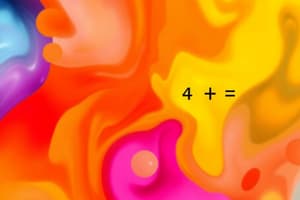Podcast
Questions and Answers
What type of data can discrete random variables represent?
What type of data can discrete random variables represent?
- Data that can take only specific, distinct values (correct)
- Data that can take any value within a given range
- Data that can take negative values
- Data that can take both whole numbers and fractions
What does the probability distribution of a discrete random variable consist of?
What does the probability distribution of a discrete random variable consist of?
- A continuous curve representing possible values
- A set of numbers (probabilities) that add up to 1 (correct)
- A graph showing the relationship between variables
- A range of specific values with equal probabilities
Which type of random variable has a probability distribution represented by a probability density function (PDF)?
Which type of random variable has a probability distribution represented by a probability density function (PDF)?
- Neither discrete nor continuous random variables
- Both discrete and continuous random variables
- Continuous random variables (correct)
- Discrete random variables
What is the probability of a specific value occurring for a continuous random variable?
What is the probability of a specific value occurring for a continuous random variable?
How are the probabilities of individual events calculated for a discrete random variable?
How are the probabilities of individual events calculated for a discrete random variable?
What is the key difference between discrete and continuous random variables in terms of their values?
What is the key difference between discrete and continuous random variables in terms of their values?
How are probabilities represented for discrete and continuous random variables, respectively?
How are probabilities represented for discrete and continuous random variables, respectively?
What is the probability of a single value occurring for a discrete random variable?
What is the probability of a single value occurring for a discrete random variable?
How are probabilities calculated for discrete and continuous random variables?
How are probabilities calculated for discrete and continuous random variables?
In what field might continuous variables be used to determine the effect of a new drug on the body mass index (BMI) of participants?
In what field might continuous variables be used to determine the effect of a new drug on the body mass index (BMI) of participants?
Flashcards are hidden until you start studying
Study Notes
Exploring the Differences Between Discrete and Continuous Random Variables
Statistics and probability form the backbone of various disciplines, including mathematics, economics, and scientific research. To understand the field more deeply, it's crucial to distinguish between discrete and continuous random variables.
Discrete Random Variables
Discrete random variables represent data that can take only specific, distinct values. They are often counted or categorized. A common example is the number of children a family has, which can only be whole numbers like 0, 1, 2, 3, and so on.
The probability distribution of a discrete random variable is represented by a set of numbers (probabilities) that add up to 1. Probabilities of individual events can be calculated using historical data, expert knowledge, or simulations.
Continuous Random Variables
Continuous random variables represent data that can take any value within a given range. They are often measured, like height, weight, or temperature. Because the values are continuous, the probability of a specific value occurring is zero. Instead, the probability is expressed as an area under a probability density function (PDF).
The PDF of a continuous random variable shows how likely it is for values to occur in a specific range. It's essential to understand that the area under a PDF must always be 1, just like the sum of probabilities for a discrete random variable.
Differences Between Discrete and Continuous Random Variables
- Values: Discrete random variables take specific values, while continuous random variables take any value within a given range.
- Probability representations: Discrete random variables use probabilities, while continuous random variables use a probability density function (PDF) and areas under the function.
- Probability of a single value: The probability of a single value occurring for a discrete random variable is a specific number, whereas the probability of a single value occurring for a continuous random variable is 0.
- Calculating probabilities: Probabilities for discrete random variables are calculated using historical data or expert knowledge, while probabilities for continuous random variables are calculated using the area under a PDF.
Applications of Discrete and Continuous Random Variables
Discrete and continuous random variables are employed in numerous applications, from social sciences like political polling to natural sciences like meteorological analysis. For example:
- In medical research, continuous variables might be used to determine the effect of a new drug on the body mass index (BMI) of participants.
- In finance, discrete variables might be used to represent the number of stocks sold in a day.
- In sports, continuous variables might be used to track the speed of a running back during a game.
In summary, understanding the differences between discrete and continuous random variables is essential for working with data. By distinguishing between these two types of random variables, you'll be better equipped to analyze data, make predictions, and draw accurate conclusions.
Studying That Suits You
Use AI to generate personalized quizzes and flashcards to suit your learning preferences.




